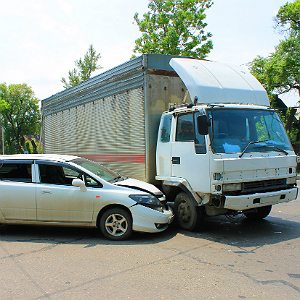It was November 2015 and a man working as a safety inspector for the Department of Transportation was at a construction site, performing his daily duties. The construction site was noisy with numerous trucks and various types of heavy machinery being used and so when one of the trucks began to back up, he didn’t notice that he was in a dangerous position until it was too late.
The truck backed over him, crushing him with its immense weight.
In a matter of seconds, the victim’s world turned upside down. Although he survived the accident, emergency physicians found that he had a broken pelvis, crush injuries to both legs, a crushed urethra and scrotum, and other internal injuries. He had to undergo immediate surgery to save his life, but even this wasn’t enough. Over the course of several weeks, multiple surgeries were required and then once released from the hospital, he required extensive physical therapy. Today, he continues to suffer from life-altering side effects from his injuries.
To try and recover compensation for his medical bills and for his ongoing pain and suffering, he filed a truck accident lawsuit.
Learn more about Staten Island Train Stations In Bad Condition, and what to look out for while traveling.
Prior to going to trial, the defendants offered to settle for $3.5 million, however, the plaintiff believed that his past and future losses would exceed this amount and rejected the offer.
During the trial, the plaintiff’s legal team gave a clear explanation as to how the accident had forever changed their client’s life and how much-continued care would cost him over his lifetime. After deliberating, the jury ordered the defendants to pay $6 million to the plaintiff.
It might seem odd for a plaintiff to be awarded future losses but the reality is that many injuries continue to require treatment for the rest of a victim’s life. In addition to this, an injury may end a career, effectively losing any salary and bonuses that the plaintiff would have been expected to earn.
Expected future medical bills and lost wages can be calculated and should be included in any amount that is recovered through either a settlement or an award.
Although it doesn’t apply in this recent case, sometimes the driver of the truck faces criminal charges such as driving while intoxicated or driving on a suspended license. While these charges may result in a conviction and the victims may feel a sense of relief knowing that justice has been served, criminal charges will never help a victim recover compensation.
Civil lawsuits are filed separately and have no impact on the outcome of the criminal trial and vice versa. However, evidence that is presented during the criminal trial may also be useful in a civil trial and an experienced attorney will know to review that evidence.

It’s wise to speak with multiple law firms before making a decision.
The attorneys of Banville Law understand how financially taxing a truck accident can be which is why we collect any legal fees directly out of the compensation that is obtained through the lawsuit. This way our clients pay nothing until they get the compensation that they need. If we don’t win, then we don’t get paid.
Call us now to learn more.
See our next blog: https://banvillelaw.com/sisters-hurt-boat-crash/
For some, one of the best activities to enjoy during the summer is to take a leisurely bike ride, enjoying the breeze and sunshine. Sadly, despite an increase in bike lanes and laws designed to protect bike riders, distracted drivers still pose a serious threat to bicyclists.
For more accident-related stories, see our last article: https://banvillelaw.com/police-officer-hits-train/
Recently, a jury awarded $1.58 million to a woman whose life was forever changed when a negligent driver prematurely ended what was supposed to be a relaxing bike ride.

She was rushed to the emergency room where she was found to have an elbow fracture and there she underwent a closed reduction procedure as well as a skin graft to close her open wound. A few days later she arrived home and consulted an orthopedic surgeon who did a more extensive workup. He determined that she also had a torn rotator cuff and torn cartilage in her wrist.
Over the next two years, she had to endure multiple steroidal pain killer injections and physical therapy. She has a permanently limited range of motion because of scarring from the accident and has difficulty performing normal household tasks. She is also unable to participate in activities she enjoyed prior to the accident. In the future, her doctor has informed her that she will need to undergo surgery to her shoulder, her elbow, and her wrist, as well as additional physical therapy.
She decided to sue the driver of the truck as well as the city because he was acting as a city employee at the time of the accident and driving a truck owned by the city.
In response to the lawsuit, the defendants alleged that the plaintiff was actually at fault for the accident and argued that she had been on an intersecting road and had been the one to turn into the truck.
After reviewing the evidence presented at trial, the jury found the defendants to be 100% at fault for the accident and awarded $1.5 million for past and future pain, $60,000 for future medical bills, and $20,800 for past medical bills.
Yes, it is absolutely possible to sue a city - or even a county or state - depending on the circumstances of an accident. These entities can be held responsible just like any other party if their negligence results in an injury.
However, the process of filing a lawsuit against a county, city, or state is slightly different and needs to be acted on as soon as possible, as there are often very short statutes of limitations. This is just one reason why it’s so important to contact a personal injury attorney as quickly as possible after an accident so that they can begin the legal process and the client isn’t in danger of losing an opportunity to recover compensation.

It’s important to remember that this can also include the anticipated future losses. For example, in this case, it is likely that the plaintiff will require additional surgery in the future which will lead to additional expenses.
No. Actually, the majority of cases are settled outside of a courtroom. In these situations, it’s best to have an experienced personal injury attorney negotiate a fair settlement. If a settlement can’t be reached, that’s when the case proceeds to trial.
At Banville Law, we carefully prepare each case from the very beginning as though it were going to go trial so that our clients feel totally prepared for all outcomes. Ultimately the choice to settle or proceed to trial is yours and our legal team will make sure you understand all of your options before you decide.
Read more: Department Of Transportation Employee Awarded $6 Million
There are few things that can be as relaxing and enjoyable as a day out on the water. Taking in fresh air and sunshine while on a boat can be combined with fun activities like wakeboarding, water skiing, tubing, and fishing and this is exactly what millions of people choose to do each year. However, water isn’t always safe.
Check out our last article on the 6 Essential Steps After A Truck Crash In New York.
During Memorial Day weekend in 2009, two sisters joined several friends on a 15-foot skiff. The group enjoyed several hours of fun before disaster struck.
Another boater behind the wheel of a 31-foot Boston Whaler was returning from a mechanical sea trial and failed to keep a proper lookout. His much larger vessel struck the skiff causing extensive damage to both the boat and those onboard.
The first sister, who is now 29-years-old, sustained a shattered pelvis for which she required open reduction surgery and internal fixation with metal plates and screws. She was also diagnosed with a ruptured spleen which had to be removed entirely and a traumatic brain injury. She now has extensive scarring on her abdomen, hips, and legs. She will likely need a total hip replacement in the future.
The second sister, who is now 26-years-old, was found to have fractured ribs, a fractured pelvis, shattered teeth, a collapsed lung, lung contusions, concussion, and nerve damage in her left foot. She also lost her senses of smell and taste entirely.
The victims of the accident were flown by helicopter to a nearby hospital but sadly, despite doctors best efforts, one of their friends did not survive.
In addition to their horrific injuries, both sisters continue to suffer from PTSD caused by the crash.
Both women decided to pursue legal action against the man who was driving the Boston Whaler which crashed into their skiff. After a lengthy trial, a jury determined that the other boater was indeed at fault and awarded the sisters compensation.
$5.6 million was awarded to the 29-year-old and $3.6 million was awarded to the 26-year-old.
When a jury awards a plaintiff with compensation they are encouraged to review all of the losses that have been sustained by that plaintiff as well as any future losses that are expected. For example, in this case, the older sister will eventually require a total hip replacement and so that is a future loss that she can be compensated for.
Although no amount of money will erase the horror of the crash and the physical pain they have suffered through, monetary compensation can help to provide a more comfortable future and a financially safe one.
Obviously, it’s impossible to paint yellow lines on water which is why it’s important for everyone to observe the rules and know who has the right of way. But often, accidents happen because boaters fail to:
If you’ve been involved in a boating accident while on vacation the best thing you can do is contact an attorney as soon as possible. Not only will the attorney determine who was at fault but they can begin the process of collecting evidence that will support a legal complaint.
When pursuing a lawsuit it’s always important to collect as much evidence as possible. This may include:
It’s important to keep everything pertaining to the accident even if you aren’t sure that it could be helpful.
If you were a guest on the boat which was driven by the at-fault driver and you sustained injuries, you may be able to pursue legal action against the driver. Basically, anyone who was hurt by the person whose negligence resulted in the collision may have the right to file a lawsuit.
See our upcoming blog: https://banvillelaw.com/bicyclist-wins-big/
While a police chase may seem exciting, the fact is that many of them end with an accident that may involve innocent citizens that were in no way connected to the officers or the person being pursued.
Our train accident lawyers are here to help you if you were injured in a train accident in New York.
In the minutes leading up to the accident, a female officer attempted to stop a man who was illegally riding his bike on the sidewalk but the bike rider took off. She attempted to follow in her cruiser but a moment after the 
The officer stopped her cruiser and watched as an inbound train crossed in front of her. Then, even though the lights were still flashing and the gate was still lowered, she decided to proceed and drove around the gates onto the tracks. What she didn’t see was an outbound train coming through the intersection.
Her police cruiser struck the second car on the outbound train and caused it to jump from the track. Luckily, the car was able to regain its place on the track instead of tipping over, however, the operator wasn’t as lucky.
The 48-year-old operator had been bounced around inside of the car due to the impact and knew immediately that he had been injured. When an ambulance arrived, he was taken to the hospital immediately with chest pain and anxiety. The ER doctors released him later in the day but he was soon back in the hospital with back pain and was finally diagnosed herniated disks from L4 - S1.
Over the next three years, he required physical therapy, epidural injections, and surgery. The cost of these medical treatments reached over $300,000 and he was unable to return to work as a train operator because of his limited range of motion.
The train operator filed a lawsuit against the city, alleging that the officer involved in the accident had chosen to 
The defendant argued that the suspect the officer had been chasing was a suspected gang member and that since he was on a bike, the order didn’t stand as it was supposed to apply to a chase involving only automobiles.
The plaintiff and defendant were unable to reach a settlement agreement and the case went to trial where the jury sided with the plaintiff and awarded him $2.5 million for past and future medical expenses and for physical pain and suffering.
Prior to going to trial, there is a period of time known as the discovery phase. During discovery, the plaintiff’s lawyer will review their medical records, consult with their doctor about any medical procedures or complications that can be expected because of their injuries, and then will often reach out to a medical specialist who can testify in addition to the plaintiff’s regular physician. This way, the jury can obtain a sense of how much the plaintiff may be expected to pay for additional treatments in the future.
Absolutely. In civil lawsuits, the defendant is the party whose negligence resulted in the plaintiff’s injuries. This can be an individual, a company, or even a government entity. At Banville Law, our team believes there is no negligent party too big or too small - if their negligence caused our client harm, we will use our passion, experience, and dedication to fight for the compensation our client both needs and deserves.
Train accident stories: Two Men Sue A Railroad After Train Derailment Kills Their Parents
Car accidents, especially those involving large trucks, can be intense and traumatic.
After a crash, victims are often overwhelmed by immediate concerns: injuries, pain and emotional distress are foremost, and worries about a damaged vehicle and the safety of loved ones aren't far behind.
In New York, train accidents are more common than you'd think. Read more here: https://banvillelaw.com/personal-injury/train-accident/
A serious truck crash will leave you rattled, or worse, but the moments directly following an accident can be the most important. That's why it's essential to gain an understanding of post-crash best practices before your next collision.
Here's how to build a better insurance claim or personal injury lawsuit from the start:
Due to their sheer size, trucks are far more likely to inflict catastrophic injuries than passenger vehicles. In cases of serious injury, you won't have a choice as to whether or not you are taken to the hospital. But after you arrive and
Even if it's just a fender-bender, your first priority should always be your own health. If the emergency responders suggest a ride to the hospital, take them up on the offer. Even if you feel fine, or your injuries seem minor.
This is just common sense, but visiting a doctor as soon as possible can also help bolster your insurance claim or a potential lawsuit. A physician's official reports, especially ones conducted directly after a crash, go to prove that you were actually hurt.
In many cases, victims with legitimate claims are denied insurance benefits based on the fact that they failed to seek treatment after their accident. Insurance companies often take this as evidence that your injuries are minor, or non-existent.
If you are involved in a relatively minor truck accident, you may be able to gather vital information essential to an insurance or personal injury claim.
After calling 911, while you wait, try to get the truck drivers:
Take pictures of all vehicles involved, highlighting any property damage, along with photos of any injuries you sustained. If you can't take photographs, make notes on the truck's appearance. Does it have a semi-trailer (large container attached to the cab)? If so, can you tell what kind of freight it's transporting, and whether or not that freight seems well secured? Is it a smaller commercial vehicle, like a delivery van?
If there are witnesses, ask for their names, phone numbers and a short description of the crash as it appeared to them. Also, request descriptions from any passengers involved in the accident.
Next, draw a diagram of the accident. Include street names for location, note the exact time and date, and then sketch out the trajectory of each vehicle involved. Try to estimate your own driving speed, as well as that of the truck that struck you.
Finally, note down any weather conditions that may have contributed to the crash. If you can, think back to the moments just before. Did you notice the truck behaving dangerously, swerving in and out of lanes, or speeding?
Once the police arrive, follow their instructions to the letter. Be courteous and clear. If they don't ask for a statement to include in their accident report, insist on it. Then describe the facts of the crash as clearly and accurately as possible, without suggesting any fault.
If you admit to being partially at-fault for the crash, this will be noted and can be used against you later on. Just describe the crash, plain and simple. Now ask to be notified of the report's completion and request a copy. You are entitled to this report by law and, in the hands of an experienced personal injury lawyer, it can become a key piece of evidence in a future claim for compensation.
At this point, you'll probably be asked whether you'd like medical attention. Accept it. Since we already covered the importance of health reports, we'll skip over that here and continue to the days following your initial examination.
Because New York is a no-fault insurance State, you are guaranteed coverage up to your policy limit regardless of whether or not you were responsible for the accident. This is a trade-off, which leaves victims with only minor injuries unable to sue a negligent driver for pain, suffering and other "non-economic damages."
Instead, New York law only allows drivers who have suffered "severe" injuries to pursue additional compensation in a personal injury lawsuit.
Before drawing on your policy, it's a good idea to contact an experienced attorney with a thorough knowledge of New York's insurance laws. Your injuries may be serious enough to file suit right away, and many "minor" injuries become severe with time.
After consulting an attorney, contact your auto insurance company. While New York State law does not require you to report an accident to your insurer, your insurance contract probably does. Failing to inform them of a crash can result in a limitation or elimination of your benefits in the event that you need them.
As with the police, describe your accident in factual terms: what, when, and where. If they request an explanation of how the crash occurred, including any questions of responsibility, refer them to your lawyer. While your insurer cannot deny you benefits on a whim, they can make life extremely difficult.
You also have to file an accident report of your own with the Department of Motor Vehicles within 10 days of a crash if:
This report is required in addition to an official police report. To properly complete the report, you'll need all the information you collected at the scene. It even asks you to draw a little diagram of the crash.
After filing your report, a record of the accident will be included on your driving record. But it won't make any mention of fault or responsibility; that's not the DMV's job.
You've covered all your legal bases, and now your mind should be focused on getting better.
If you've decided that insurance is the best way to go, just follow your doctor's guidance and file claims as needed. If, on the other hand, an experienced attorney believes that you have a valid case, work together to build the strongest lawsuit possible.
Read more: Police Officer Drives Onto Train Tracks & Strikes Oncoming Train
Especially in the past year, New York train accident attorneys have noticed the incline in train accidents that cause injuries to hundreds of people. Although each crash has a different cause, one thing is becoming increasingly clear: these accidents could have been prevented.
Two adult sons also believed that the train accident which claimed their parent’s lives also could have been prevented and chose to file a lawsuit stating just that.
The two victims named in this complaint were the 69-year-old father and 70-year-old mother of the plaintiffs. At the time of the accident, they were traveling on a bridge in their car, in lanes that 
Little did they know that above them was a “sun kink” which is a malformation or buckle in the track caused by extreme heat. While they continued on their way, a train passed on the tracks above them and hit the buckle. It caused the train to derail and the bridge to collapse on top of them.
Both of them sustained fatal injuries and it wasn’t until two days later while the rubble was being cleared that their bodies were found.
Their sons decided to file a lawsuit on behalf of the victims against the railroad company and several of its employees, including a track inspector and signal maintainer. They alleged that the defendants were completely aware of the sun kink and instead of taking appropriate action, like removing traffic from that specific track or scheduling a repair, they ignored the issue.
They provided evidence that earlier in the day the signal maintainer had noticed an issue on the track and had requested that the track inspector look into it.
The plaintiffs requested compensation for their parent’s lost income, the loss of their companionship and guidance, and for the conscious pain and suffering that doctors believed their mother had experienced before her death.
The defendants denied that a sun kink ever existed and instead blamed the derailment on excess metal that had been welded into the track and had been present for an extended period of time. They did not, however, provide evidence that they had attempted to repair this other hazard.
The case never went to trial. Instead, the parties settled out of court for $8.5 million.
Whenever the negligent acts of one party result in the untimely death of another, the surviving loved ones or estate of the deceased party has the option of filing a personal injury lawsuit. Parties who are eligible to file typically include the surviving children, spouse, or parents.
These complaints can provide the plaintiffs with compensation for:
The process of filing isn’t simple, however, and the best way to help find the justice that is needed and deserved for the deceased is to work with an experienced attorney.
Every case is different but even lawsuits that reach the quickest conclusion take at least a few months. It takes time to file the correct paperwork, contact witnesses, collect evidence, find experts to testify on the plaintiff’s behalf, and then wait for a trial date.
It’s not uncommon for the defendant to offer a settlement agreement while waiting for trial. There are benefits to this - it saves all parties additional time and money and it allows the plaintiff to know exactly how much they will be obtaining. An attorney can, in most cases, negotiate a higher settlement than what is initially offered.
Plaintiffs do not have to accept the offer and in those instances, the case will go to trial.
No. Again, all complaints are different and the losses sustained in each case are different. Damages that are awarded to a plaintiff can range from thousands to millions. Once an attorney has reviewed a case, they can provide their client with an estimate of what their case may be worth.
Did you know the Staten Island Train Stations In Bad Condition? Keep reading to find out details.
A truck driver, who now suffers from paraplegia, has won his lawsuit against both Empire Truck Sales and the manufacturer of the seat belt that was used in the tanker involved in his truck accident. He was awarded the largest sum available in the high-law agreement that was offered by the defendant.
Read more from our New York train accident attorneys here.
The driver took his tanker truck to Empire Truck Sales for preventative maintenance. At that time, he alleges that the mechanic who worked on the truck failed to replace lock nuts on the lateral control rod.
A month later, he returned to the mechanic, reporting that the truck was abnormally vibrating at high speeds and that it was also making grinding noises. The mechanic once again failed to inspect the lateral control rod. He did determine that the antilock braking system (ABS) did have an issue, but he did not properly fix it.
A few days later while on the road, the driver noticed that the ABS warning light had turned on. He called the shop, and was assured him that the braking system was fine. He continued to drive the truck, and later that day when he applied the brakes, the system failed. The truck careened out of control and crashed.
When the truck crashed, it flipped over. The driver, who was only twenty-seven years old at the time, was taken to the hospital where he was diagnosed with a severed spine. Surgeons attempted to repair the injury, and he underwent extensive physical therapy, but the injury resulted in paraplegia. He is required to self catheterize daily and continues to suffer from depression, PTSD, neuropathic pain, muscle spasms, and pressure sores.
Doctors have estimated that the future cost of his care will be at least $1.7 million.
The driver sued Empire Truck Sales, alleging that they were liable for the mechanic’s negligence. He presented evidence that showed the company had warned the mechanic in the past about leaving parts of a vehicle out of his inspection. He also alleged that they were negligent because a representative assured him that the truck’s antilock braking system was fine when he called to report the warning light had turned on.
He also brought a crashworthiness complaint against Indiana Mills and Manufacturing Inc., and Daimler Trucks North America, the manufacturers of the truck, and the seat belts inside of the truck.
This complaint alleged that the seat belt had a “false latch condition”, which meant that the buckle would appear to be completely inserted, but it was in fact, not. As a result, when the crash occurred, his seat belt came undone and he was thrown against the truck’s cab.
Both the seat belt manufacturer and truck manufacturer settled out of court before trial, for an undisclosed amount.
The case against the Empire went to trial. The defendant's legal team argued that the plaintiff had been warned of the issue with the braking system when he picked the truck up, but drove it anyway. They also alleged that the plaintiff initially reported to his doctors and loved ones that the truck had hydroplaned prior to impact, but changed his story later on.
A high-low agreement was reached, the high amount being $14 million, the low being $2 million.
At the end of the trial, the jury awarded $18.79 million in compensatory damages and $5 million in punitive damages. Due to his high-low agreement, the plaintiff was given $14 million.
High-Low agreements are designed to create parameters of maximum exposure for the defendant and the minimum amount of recovery for the plaintiff. Once the amounts are set, both parties must disclose the agreement to the court.
This is a way that plaintiffs can rest easy knowing that they will be guaranteed a specific minimum amount if the verdict is in their favor, and the defendant is protected against excessively high verdicts.
Find more reading: 6 Essential Steps After A Truck Crash In New York
New York State Senator Diane Savino recently created a report that brought to light the issues with the Staten Island train system that many riders have been concerned about for a long time. While there were plenty of complaints about where the rail system does not run, concerns about each railway station were also voiced. People are concerned about the unsafe conditions at the Staten Island train stations and it is something the Metropolitan Transportation Authority (MTA) needs to address.
With train accident lawsuits on the rise, it's important to have the necessary information you need to stay safe in train stations.
A report released by Senator Savino goes through every Staten Island train station and outlines the issues that each station faces. Some of the unsafe conditions include:
Riders complain about the pervasive urine odors that are found in most of the Staten Island railway stations, and many riders indicate that the stations are simply not healthy places to be. The trains themselves are also said to be very unclean, have a stench that is unhealthy and are too old to be safe anymore.
When you talk at length to the people who ride the Staten Island railway system, you get the impression that this rail system is unsafe and unhealthy from the moment the rider walks into the railway station at their point of origin, to the time when they reach their destination. When those destinations lack proper lighting and have no parking lots to make it safe to pick up and drop off riders, then you get a system that has a long way to go to be truly safe for the public.
The fact that 4.4 million people ride the Staten Island rail system every year highlights the severity of the problem at each railway station. In Senator Savino's report, she indicates that the unsafe conditions at the railway stations were the top priority for riders. While the MTA may be slow to react, the conditions at each station are not going to improve on their own.
According to SecondAvenueSagas.com, the sticking point to repairing the railway stations will be money. The people of Staten Island want their stations to be safer, but the renovations and repairs will cost money. The MTA has a long list of projects it needs to consider throughout New York City, and many of those projects could take money away from the Staten Island train stations for now.
So, what are riders supposed to do about their own safety while the finances of the railway station repairs get hammered out?
If you walk along a MTA platform in Staten Island and slip in a puddle of liquid and fall, the MTA is more than likely not going to be liable for your injuries. However, if you trip in a hole in a platform, then the MTA could be liable because they are responsible for the upkeep of their railway stations.
The question of what Staten Island railway riders are supposed to do while the MTA schedules repairs to deteriorating rail stations is not an easy one. Of course, the MTA is not liable if you get sick because you had to stand out in the rain to catch a train. But what if faulty lighting and a lack of security lead to you getting attacked one night at a station? Is the MTA liable? Should the MTA have taken action to prevent what happened to you? The answer to these questions is yes, the MTA is responsible for such matters.
If you find yourself in a harmful situation due to the conditions at the Staten Island railway stations, then you could have a personal injury case. In such dilapidated train stations, the possibility of falls happening are so high, and the injuries that can come out of this can greatly hamper your quality of life. If falls happen due to the conditions of these train stations, seek both legal and medical help.
To read more about accident-related cases, check out our next blog: https://banvillelaw.com/high-low-settlement/